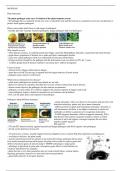Class notes
Plant Immunity (MCB3024S) notes
- Course
- Institution
Comprehensive lecture notes for the Plant Immunity module covered in MCB3024S. These notes cover all content taught in lectures as well as additional materials (powerpoints, textbooks) required to succeed. These notes were created by a student who achieved a distinction in this course.
[Show more]



